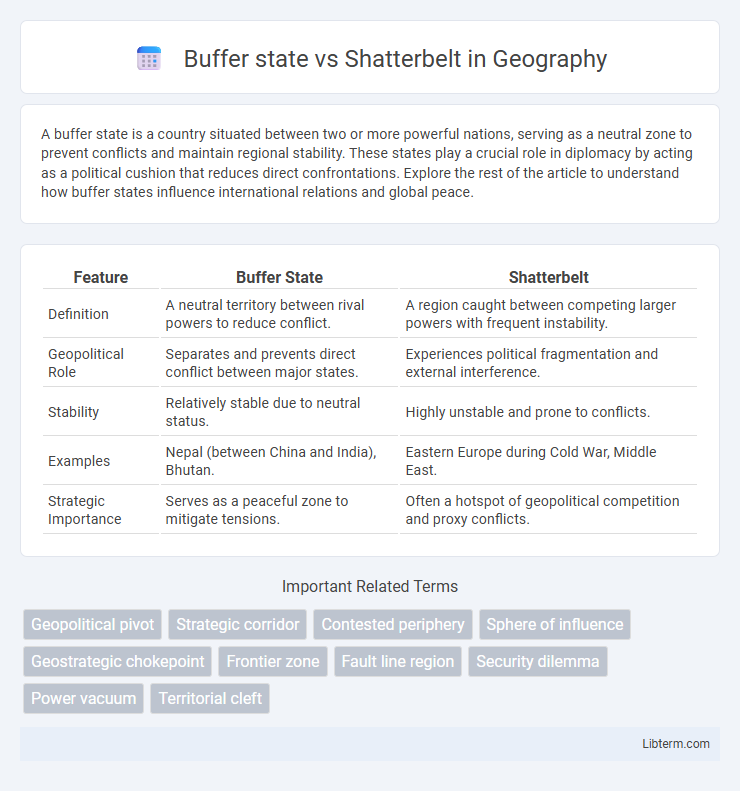A buffer state is a country situated between two or more powerful nations, serving as a neutral zone to prevent conflicts and maintain regional stability. These states play a crucial role in diplomacy by acting as a political cushion that reduces direct confrontations. Explore the rest of the article to understand how buffer states influence international relations and global peace.
Table of Comparison
| Feature | Buffer State | Shatterbelt |
|---|---|---|
| Definition | A neutral territory between rival powers to reduce conflict. | A region caught between competing larger powers with frequent instability. |
| Geopolitical Role | Separates and prevents direct conflict between major states. | Experiences political fragmentation and external interference. |
| Stability | Relatively stable due to neutral status. | Highly unstable and prone to conflicts. |
| Examples | Nepal (between China and India), Bhutan. | Eastern Europe during Cold War, Middle East. |
| Strategic Importance | Serves as a peaceful zone to mitigate tensions. | Often a hotspot of geopolitical competition and proxy conflicts. |
Understanding Buffer States: Definition and Features
A buffer state is a neutral territory established between two or more powerful conflicting countries to prevent direct confrontation and maintain regional stability. Characterized by limited political or military influence, buffer states often have restricted sovereignty and serve as a cushion absorbing tensions without escalating conflicts. Unlike shatterbelts, which are regions of persistent instability and fragmentation due to competing powers, buffer states function primarily as peacekeeping zones that mitigate aggressive interactions.
What is a Shatterbelt? Key Characteristics
A shatterbelt is a geopolitically unstable region caught between stronger external powers, often characterized by internal fragmentation and frequent conflict. Key characteristics include high ethnic or cultural diversity, weak governance, ongoing territorial disputes, and susceptibility to external influence or intervention. These regions typically experience chronic instability due to competing strategic interests of surrounding powers.
Historical Examples of Buffer States
Buffer states such as Afghanistan between the British and Russian empires during the 19th century or Poland between Germany and the Soviet Union before World War II served as territories that separated two rival powers, reducing direct conflict. In contrast, shatterbelts like the Balkans exhibited intense political fragmentation and external intervention due to competing influences from larger powers. Historical buffer states functioned as zones of strategic defense and diplomatic negotiation, preventing immediate confrontation by absorbing tensions between empires.
Notable Shatterbelt Regions in Geopolitical History
Notable shatterbelt regions in geopolitical history include Eastern Europe, the Middle East, and Southeast Asia, where intense power struggles have shaped unstable borders and competing alliances. These areas are characterized by their strategic importance and ethnopolitical fragmentation, leading to persistent conflicts and shifting control among major powers. Unlike buffer states that serve as neutral zones to reduce direct confrontation, shatterbelts endure ongoing volatility due to their position between rival geopolitical interests.
Strategic Importance: Buffer State vs Shatterbelt
Buffer states serve as strategically important zones that separate major powers, reducing the likelihood of direct conflict by creating a neutral or friendly territory that absorbs geopolitical pressure. Shatterbelts, characterized by fragmented political entities and intense conflict, hold strategic significance due to their potential to influence regional stability and act as battlegrounds for competing powers. Control over buffer states ensures security through diplomatic neutrality, while dominance in shatterbelt regions offers opportunities for power projection and resource access amidst ongoing instability.
Factors Influencing State Vulnerability
Buffer states experience vulnerability due to geographic proximity to rival powers and limited military capacity, making them susceptible to external influence and conflict spillover. Shatterbelts, characterized by deep ethnic divisions and geopolitical fragmentation, face heightened instability caused by internal factionalism and competing external interests. Both concepts emphasize how political, ethnic, and strategic factors critically influence a state's susceptibility to conflict and external control.
Impacts on Regional Stability and Security
Buffer states act as neutral zones that reduce direct conflict between major powers, thereby enhancing regional stability by preventing territorial disputes. Shatterbelts, characterized by internal fragmentation and external influence, exacerbate instability and security dilemmas due to ethnic conflicts and proxy wars. The presence of buffer states generally promotes peaceful coexistence, while shatterbelts often become hotspots for regional tensions and military interventions.
Role of Major Powers in Buffer and Shatterbelt Dynamics
Major powers strategically establish buffer states to create zones of influence that reduce direct conflict risks by separating rival powers, exemplified by the Cold War's division of Eastern and Western Europe. In contrast, shatterbelt regions--such as the Middle East and the Balkans--experience intensified competition among major powers, where external interventions exacerbate fragmentation and instability. The roles of these powers in buffer states aim at containment and stability, while in shatterbelts, their involvement often fuels volatility and geopolitical tension.
Modern Case Studies: Buffer States and Shatterbelts
Buffer states such as Mongolia between China and Russia serve strategic roles by preventing direct conflict between major powers, highlighting their significance in modern geopolitics. Shatterbelts like the Middle East demonstrate regions fragmented by ethnic, religious, and political divisions, resulting in persistent instability and external interference. Contemporary conflicts in Eastern Europe and Southeast Asia further exemplify how buffer states and shatterbelts influence global power dynamics and regional security.
Future Geopolitical Trends: Buffer States vs Shatterbelts
Future geopolitical trends suggest buffer states will increasingly act as strategic zones mitigating direct conflicts between great powers, maintaining regional stability through neutrality or alliances. Shatterbelts, characterized by persistent fragmentation and ethnic complexities, are likely to experience intensified internal conflicts and external interference, exacerbating geopolitical volatility. Understanding the evolving dynamics of these regions is crucial for predicting areas of potential conflict or cooperation in global diplomacy.
Buffer state Infographic

 libterm.com
libterm.com